Coconut Octopus
Amphioctopus marginatus
Coconuts may not migrate, but they can be carried — by a coconut octopus! This species has been seen stacking coconut shells and carrying them under their arms, like how you might carry a barrel.
To move around with the shells, the octopus uses some of its arms to “walk” along the seafloor as if it’s on stilts! It’s a bit awkward, but the coconut shells are handy tools.
Size
12 in long (30 cm)
Lifespan
3-5 years
Habitat
Shallow seas — sand, mud
Diet
Crabs, clams, shrimps
Range
Tropical Indian & western Pacific Oceans
Predators
Viperfish, great white sharks, larger octopuses
superpower
Transforming Armor
If a predator approaches, these octopuses assemble their coconut shells (or seashells) around themselves as armor!
SCIENTIFIC NAME: Amphioctopus marginatus
There are 14 recognized species that belong to the Grimpoteuthis genus of umbrella octopuses.
After a molecular study in 2003, it was suggested cirrate octopuses be divided into four familes: Cirrotheuthidae, Opisthoteuthidae, Grimpotheuthidae, and a new family to include Cirroctopus.
New methods, such as submersibles that can record video and gently collect specimens, have allowed substantial new observations and sparked interest in this deep-sea group, therefore taxonomy of deep sea cirrate octopuses is in review.
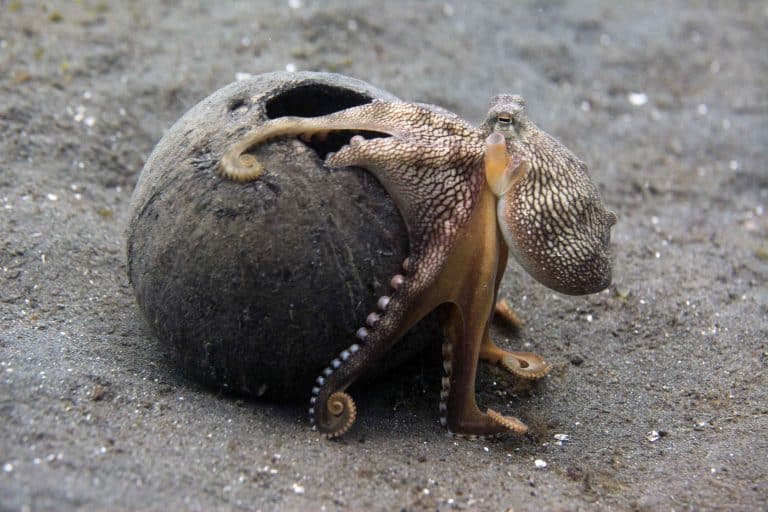
HISTORY OF THE DUMBO OCTOPUS
Although Grimpotheuthis umbrellata was first discovered in 1884, this particular dumbo octopus is still not well known. This species was first described from three specimens: one large specimen taken from the Azores (at 2235 meters depth) and two smaller specimens from off the coasts of Morocco and the Carnaries.
From the two smaller specimens, one is extinct and the other has been identified as an Opisthoteuthis (flapjack octopus). Therefore, one specimen remains for G. umbrellata and it is in poor condition. Most of the characteristics described apply to the genus Grimpotheuthis.
SIZE OF THE COCONUT OCTOPUS
The coconut octopus is a small to medium-sized octopus with a mantle length to 100 mm (4 in) and a total length around 300 mm (12 in). The arm length of the coconut octopus is 2 to 3 times the mantle length and there are around 150 suckers on each normal arm. This species weighs in around 400 g (almost 1 lb!).
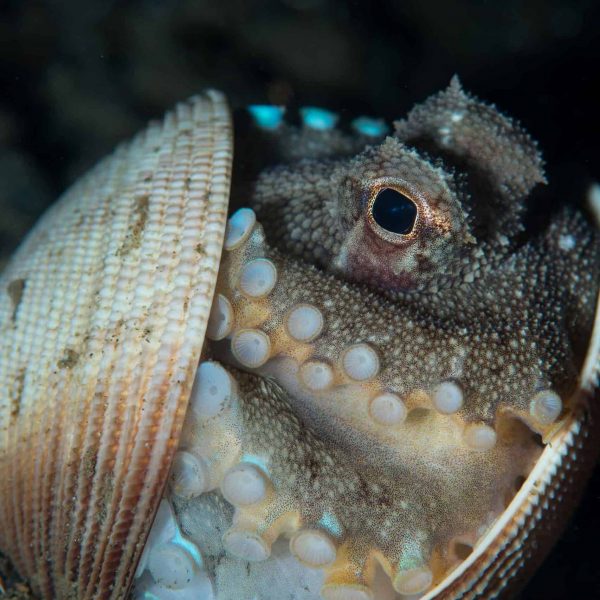
COCONUT OCTOPUS LIFESPAN
For a small to medium-sized octopus, this species has one of the longer life spans of 3-5 years.
DISTRIBUTION
The coconut octopus is considered a tropical water species inhabiting the waters of the Indian Ocean, from Durban, South Africa, to Red Sea, India, south-east Asia, Taiwan, Philippines and Japan, as well as east to north-eastern Australia.
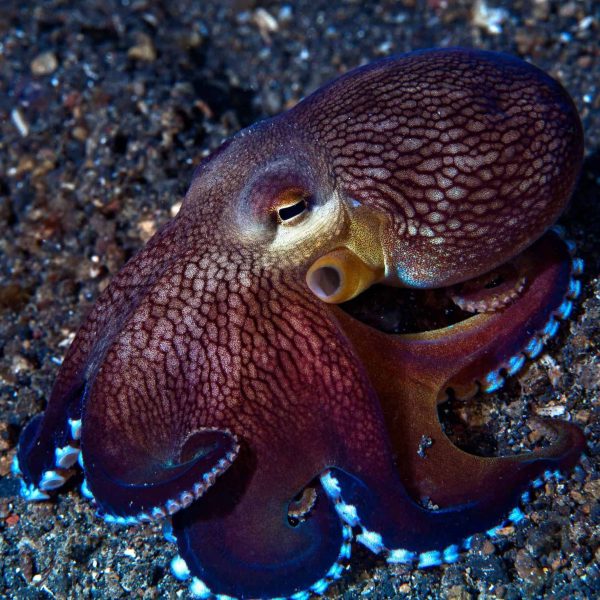
HABITAT
This benthic octopus prefers shallow coastal waters and mostly inhabits sandy or muddy seafloors. It is frequently found in bays, lagoons, and inlets. It constructs its den out of clamshells, coconut shells, bottles, and other man-made discarded objects.
DIET
Dusk and dawn are the hours this octopus actively hunts. The coconut octopus feeds on crabs, clams, and shrimps.
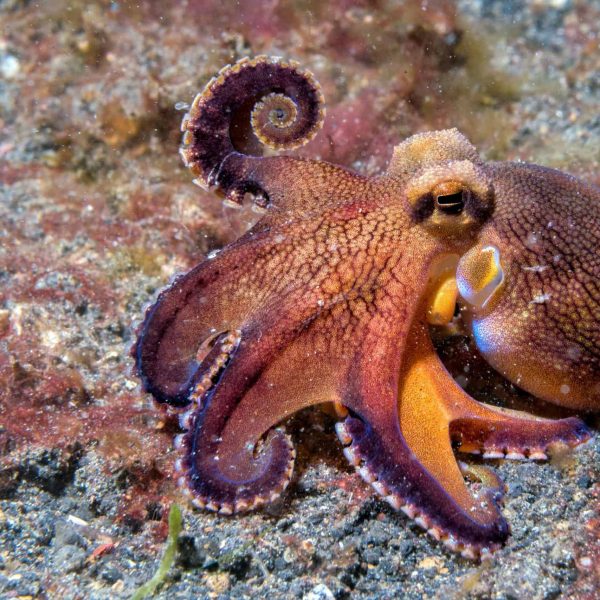
BODY PATTERNS AND BEHAVIORS
The coconut octopus can be tan-brown in color to blend-in with its environment. Its most distinguishing body pattern is purple background with dark purple-brown branched lines which take on a vein-line pattern. The funnel is usually a yellowish shade. This species has a narrow transverse “head bar” and a pair of white spots present on its dorsal mantle.
For skin sculpture, this species has four longitudinal skin ridges in a diamond shape on its dorsal mantle and a single large papilla over each eye. The most distinctive feature of the coconut octopus is its suckers. The suckers are white to pink and really stand out against the dark brown to black border along the edge of its arms.
This octopus’ common name originates from its behavior to carry coconut shells. A group of researchers studied a range of behaviors for the coconut octopus off the coasts of Northern Sulawesi and Bali in Indonesia. They completed 500 dive hours and observed more than 20 individual octopuses (science is hard work!).
On four occasions, octopuses were observed to travel over substantial distances (up to 20 m or 65 ft!) while carrying stacked coconut shell halves under their arms. To carry shell(s), the octopus manipulated and arranged the shell(s) so the concave surfaces were upright, extended its arms around the outside, and walked using its arms as rigid limbs. The authors description of this behavior gave us a chuckle as we envisioned the “lumbering octopedal gait”, which they called “stilt walking”.
Do coconut octopus use tools?
Simple behaviors such as the use of an object (or objects) as a shelter are not typically considered as tool-use because the shelter is in use all the time. An example of this is a hermit crab using a gastropod shell. A tool provides no benefit until it is used for a specific job. When being carried, the shells offer no protection and place a cost on the octopus to use this awkward form of locomotion, stilt walking.
However, the benefit must out-weigh the cost. When they need to hide from predators (viperfish, great white sharks, and larger octopuses), the octopus assembles the shells for shelter. The octopus is carrying the shell (or shells) for future use rather than part of specific tasks such as using rocks to barricade the entrance to its den.
Further evidence suggests this demonstrates tool-use behavior because the octopus is required to correctly assemble the separate parts (when transporting two shells in a non-functional form) to create a single functioning tool when needed.
This behavior has likely evolved from the octopus using large, empty bivalve shells prior to the coconut shell halves being discarded by the coastal human communities near-by this species habitat. Tools were once thought of as the defining feature of our species; however, tool-use behaviors have been revealed in other primates and a growing range of mammals and birds. Now, there is even support for marine invertebrates to engage in tool-use, a benchmark for cognitive sophistication.
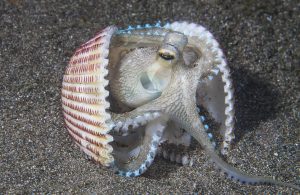
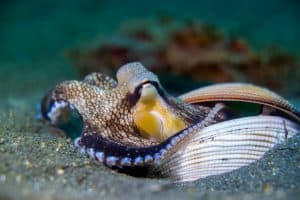
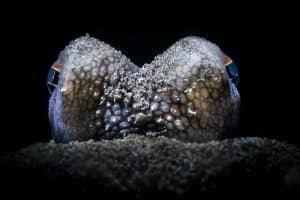
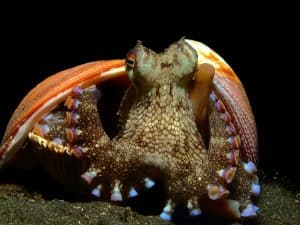
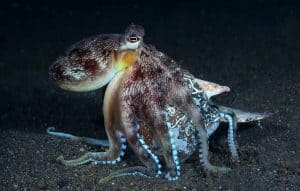
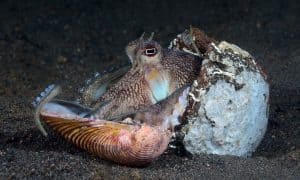
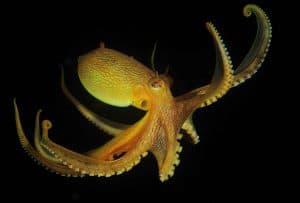
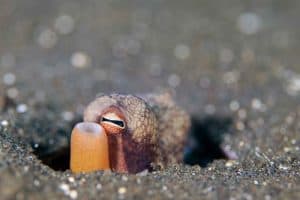
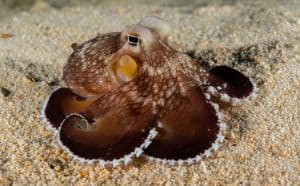
ATTITUDES AND MODES OF LOCOMOTION
The development of new technology, such as manned submersibles, has opened new horizons for deep sea exploration! The manned submersible Nautile was able to film behavioral observations of Grimpoteuthis at depths between 2702 – 4527 meters (1.7-2.8 miles) on the Mid-Atlantic Ridge.
Scientists observed octopus’ bottom-resting attitude and three modes of locomotion: crawling, take-off, and fin-swimming. Bottom-resting was observed when the octopus’s arms and web were out-spread, fins were extended parallel to the bottom, eyes were open, and mantle erect and pointing backwards at a slight angle. Starting from bottom-resting, octopus would crawl slowly backwards with all arms extended. Once the octopus gained speed, movement of the right and left arms was symmetrical. If the octopus was disturbed, it would take-off from bottom resting or crawling as a sudden escape reaction.
Take-off comprised a single, strong pulsation generated by contraction of the arm crown and was sometimes accompanied by a forceful stroke of the fins. The octopus would pull its body into a fusiform shape, mantle first with the arms trailing behind, and continue by fin-swimming a few meters off the bottom. The number of fin strokes per minute ranged from 4 to 30!
Sreeja V and Bijukumar A (2013) Ethological studies of the Veined Octopus Amphioctopus marginatus (Taki) (Cephalopoda: Octopodidae) in captivity, Kerala, India. Journal of Threatened Taxa. 5:4492-4497.
Finn JK, Tregenza T, and Norman MD (2009) Defensive tool use in a coconut carrying octopus. Current Biology 19:1069-1070.
Voss GL and Williamson GR (1971; as Octopus aegina), Roper CFE et al. (1984; as O. aegina), Norman MD (1992c), Norman MD and Hochberg FG (1994, 2005a), Norman MD and Kubodera T (2006), Finn JK et al. (2009), Huffard CL and Godfrey-Smith P (2010). IN Jereb P, Roper CFE, Norman, MD, Finn JK (eds) Cephalopods of the world. An annotated and illustrated catalogue of cephalopod species known to date. Volume 3. Octopods and Vampire Squids. FAO Species Catalogue for Fishery Purposes. No. 4, Vol. 3. Rome, FAO. 2014. 370 p